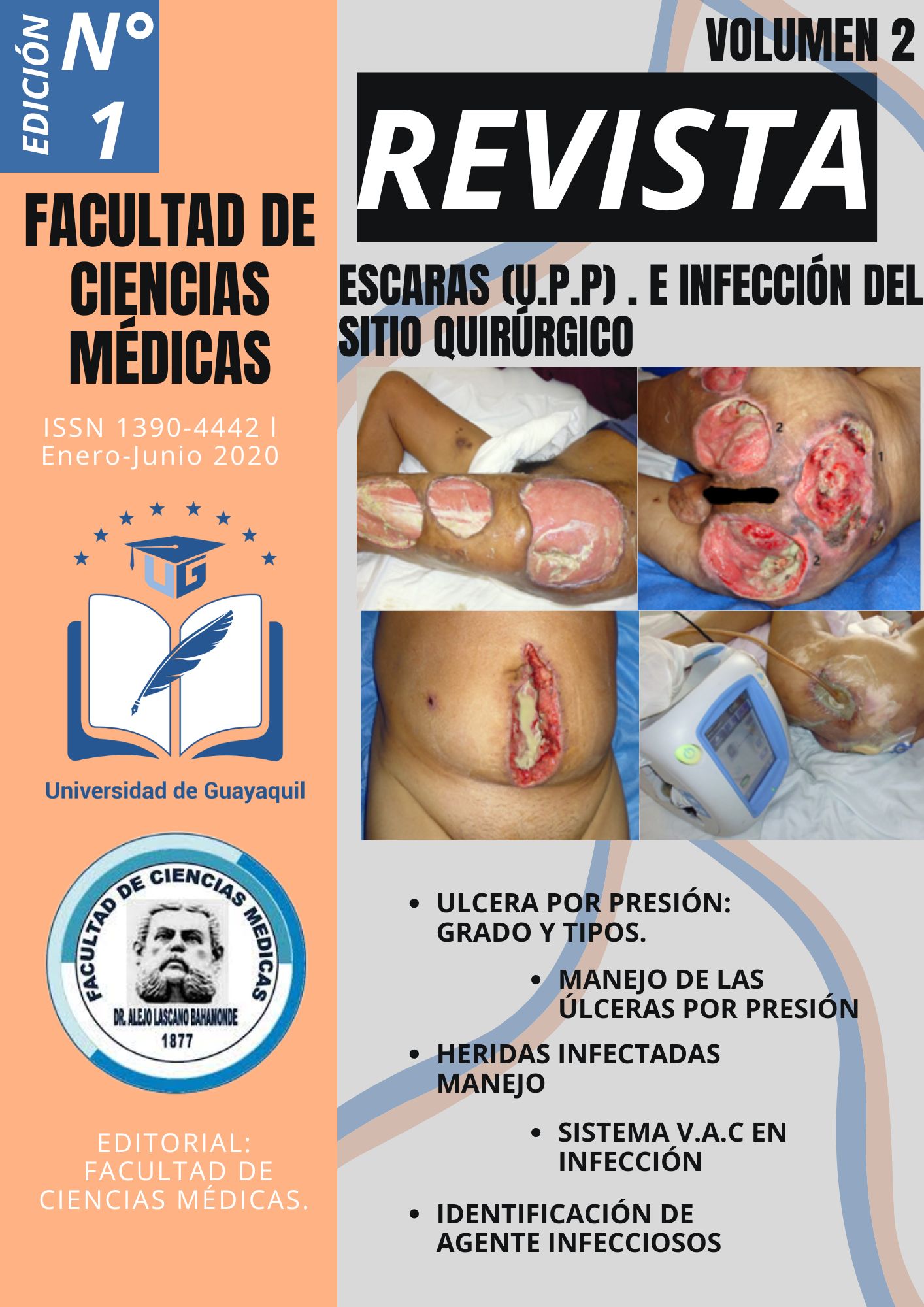Surgical Site Infection (I.S.Q) - Management from the Advanced Wound Care Unit
Patients undergoing surgery Hospital Abel Gilbert Pontón 2018 - 20219
Keywords:
surgical site, infection, dressingsAbstract
Surgical site infection is one of the most common complications after surgery with an incidence ranging from 2 to 5%, causing increased hospital stay and high costs. The Centers for Disease Control and Prevention (CDC) of the United States of North America define SSI as an infection that affects the skin and subcutaneous cellular tissue. According to the National Nosocomial Infections Surveillance (NNIS), SSI can be classified into: 1.- superficial, when it affects skin and subcutaneous cellular tissue, 2.- deep, when it affects fascia and muscle 3.- organs or cavities, that is exposed or open.
In general, the type of germ that causes infection of the surgical site will depend on its origin, or if the exogenous or endogenous contamination, thus if the origin of the skin is usually caused by Gram positive (Staphylococcus epidermidis or negative coagulase, S. aureus or coagulase positive, enterococcus) but if it is from the gastrointestinal tract, it is usually Gram negative or anaerobic (Escherichia coli, Klebsiella, Bacteroides fragilis).
At the present time, with the development of the so-called high-tech dressings or active dressings (hydrogel, hydrocolloids, activated carbon, bacterial uptake, etc.), advanced healing equipment and the name of wet-environment healing were also developed with positive results.
References
Ban AMJLCHBJEFDD.: American College of Surgeons and Surgical Infection Society: Surgical Site Infection Guidelines. Journal of the American College of Surgeons. 2017; 1: p. 59-74.
Loyola ÁSM.: CURA DE HERIDAS QUIRÚRGICAS. PROTOCOLO DE ACTUACION. 2015-2016.
García DPY.: INFECCIONES QUIRURGICAS. guías clínicas de la asociación Española de cirujanos Segunda Edicion .2016.
B. Mirelis Otero NLE.: Conceptos de Microbiologia Aplicada. GUIA CLINICA DE LA ASOCIACION ESPAÑOLA. SEGUNDA EDICION 2016.
Gil Rodríguez-Caravaca.: SSRMCVdCRMLAGdM. Adequacy Assessment of Antibiotic prophylaxis surgery. Enfermedades Infecciosas y Microbiología Clínica. 2015.
Hodonou MASTSHFMAF.: Epidemiological Aspects of Surgical Site Infections in an Income Country: The Case of Regional Hospital Centre, Borgou (Benin). International Journal of Medical Researc h & Health Sciences. 2017;: p. 29-33.
Morales R BJ.: Control del foco séptico en infección quirúrgica. Infecciones quirúrgicas. Guías clínicas de la asociación española de cirujanos. 2016; 2da: p. 177-229.
Sánchez B.: Infecciones asociadas a procedimientos quirúrgicos. Trabajo de fin de grado". Universidad de La Laguna, España. 2017;: p. 1-19.
Jiménez MMJQGLCNJFR.: Guía para la prevención de la infección del sitio operatorio (ISO). Asociación Colombiana de Cirugía. 2015.
Clara LAPBGBHCECAea.: Guía de Profilaxis Antibiótica Quirúrgica. Sociedad Argentina de Infectología. 2017; 2da: p. 1-57.
Odionnys Ramos-Luces.: NMGWPDJMRAVRJGL. Infección de heridas quirúrgicas en cirugía general. 2015; 79: p. 349-355.
Sánchez Brizuela.: Morbimortalidad por infecciones posoperatorias en un servicio de Cirugía General Rev. Arch Med Camagüey Vol23(3)2019
Despaigne Alba I, Consideraciones actuales sobre las infecciones posoperatorias. MEDISAN [Internet]. Abr 2013 [citado 24 Abr 2019];17(4).
Fajardo Rodríguez HA.: Escalas de predicción e infección de sitio quirúrgico en 15 625 cirugías (2001- 2003). Rev Salud Pública [Internet]. 2005 [citado 26 Oct 2017];7.
Morales R.: Control del foco séptico en infección quirúrgica. En: Badia JM, Guirao X. Infecciones quirúrgicas. Guías clínicas de la asociación española de cirujanos. 2ª ed. Madrid: Arán Ediciones SL; 2016. p. 177-229.
Gómez Romero F.: Prevención de la infección de sitio quirúrgico: análisis y revisión narrativa de las guías de práctica clínica. Cir esp 2017; 95(9): 490–502.
Ángeles G.: Factores de riesgo relacionados con infección del sitio quirúrgico en cirugía electiva. Revista de Cirugía y Cirujanos. Volumen 82, N° 1, Enero-Febrero 2014. Pág. 48-62.





